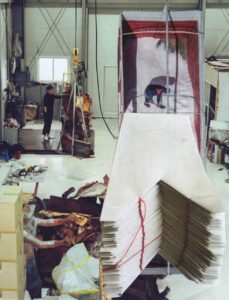The sexual assault and misconduct allegations against film producer Harry Weinstein that began to emerge on October 5, 2017 have precipitated a wave of similar allegations against powerful men, in some cases, ending decades-long careers. One of the many striking things about these revelations is that this kind of behavior has been widespread and repressed—hidden, disavowed, ignored—for generations. While not all allegations are being treated seriously—take, for example, US President Donald Trump’s earlier dismissal of allegations of sexual assault and misconduct during his presidential campaign—their sheer volume indicates the possibility of a change in understanding, and expressions, of sexuality and power in American and European societies.
For each of us, one of the many scandals probably made this thing personal. For me, a resident of Minnesota, it was the fall of our Senator Al Franken, who I had watched with admiration as he posed pointed, ethical questions to Trump’s pick for the US Supreme court, Neil Gorsuch, on his lack of sympathy for a trucker who nearly froze to death in the cab of his truck. “Just the kind of principled approach to politics that we need from our representatives,” I thought. But when Leann Tweeden revealed that Senator Franken had kissed and groped her without her consent, I had to re-evaluate my understanding of this public servant.
In reading about Tweeden’s choice to share her experience publicly, I discovered it was not in order to call for Franken’s resignation. Rather, the language she used corresponded with a therapeutic approach. As she put it: “I’ve wanted to tell this story because it’s bugged me for so long. It’s made me angry for so long. I’ve been humiliated for so long. Now is the time — don’t wait, don’t hold it in … We’ve got to change the culture. We’ve got to change the silence.” It occurred to me that, given the attention to the unearthing and processing of difficult experiences in the consulting room, depth psychology and psychoanalysis could have useful insights for those of us grappling with what these revelations mean—and possibly portend—for our societies, and the expressions of sexuality and power therein.
So, I turned to therapist, cultural theorist, and director of Stillpoint Spaces London, Aaron Balick, PhD, who was kind enough to share some reflections on the connections, similarities, and differences between the therapeutic and popular contexts where past experiences of sexual misconduct come to light.
~Anne Marie Wirth Cauchon
AMWC: So, first of all, in the following questions, I am going to ask you to make some extensions from the therapeutic and theoretical expressions of psychoanalysis and depth psychology, and into the social and political realm. Can you start by talking about the extent to which clinical experience can relate to the world outside the consulting room?
AB: The allegations of sexual misconduct that we are hearing so much about in the public sphere are similar to the kinds of disclosures that are often made in the therapy room. However, the therapist’s goal is quite different from that of either law enforcement or the businesses and corporations that need to respond to allegations made about their staff. The therapeutic role is to hold a non-judgmental space for the individual to understand better what has happened to them and the consequences of that, process that psychologically and emotionally, and explore how they might respond if they choose to. Unless there is an overwhelming reason to, therapists will generally not actively encourage their client to make official claims, but allow space for an individual to come to that decision themselves. Oftentimes these claims are not taken forward, either because they happened too long ago, the individual fears repercussions, or they judge it’s simply not how they wish to move forward. Conversely many others do take their allegations further, often at great risk to themselves and their family lives. If there is a clear danger to others, a therapist may break confidentiality and make a claim themselves – but in all cases would try their best to have their client aware and on side.
Whatever happens, the secure space needs to be held to explore the experience outside the pressure of disclosing elsewhere. Those who have been on the receiving end of sexual misconduct or abuse are often vulnerable, and know the risks of making it public. The therapeutic space is an opportunity to explore what happened, and the meaning that has for the individual outside (by some degree anyway) the imperative to report.
AMWC: In Freudian psychoanalysis and its model of the unconscious, some forms of repression are integral to an individual’s normal functioning and to his/her/their development. However, the repression of traumatic events can result in psychological distress and in the emergence of symptoms. In this model, recalling traumatic events can have a therapeutic effect. Do you think that recalling the trauma of the many sexual assault allegations that have emerged since the Harvey Weinstein affair can have broad ‘therapeutic’ effects for society or politics at large?
AB: There is a big difference between recalling and processing. Much of the recalling or retelling that happens both within or without the consulting room is not processing, and can often be re-traumatising. Working with traumatic material needs to occur in a contained environment, that is, within a context of deep listening, care, and understanding. Furthermore, the therapist needs to actively work with traumatic memory to enable processing the material rather than re-experiencing the trauma. This is what is ideally offered in the consulting room. It is hard to see how such deep containment can be sustained across social media.
If there is anything therapeutic about recent events , it is that people have become aware how prevalent such sexual misconduct is, and how many people, especially women, have suffered some form of it. This was represented widely in the #metoo meme in which both men and women from around the globe have supported each other to come out about their experiences. This has, in effect, thrown light on a rather dark issue, enabling people to feel less alone with it, and requiring society to “wake up” to the scale and commonality of such events.
However, the jury is out about whether this will make much of a difference in transforming culture or enabling greater understanding of this phenomenon; my concern is that the complexity of the issue will become diluted on to black and white themes of perpetrator and victim, blame and resolution. Furthermore there is the risk of people becoming inured to hearing story after story in such a concentrated period of time. A possible consequence of this is that those who speak up early get attention whereas those that come later may get lost in the sea of disclosures. Furthermore, because of the lack of complexity across social media, there is little nuance, meaning that various kinds and degrees of misconduct get conflated.
AMWC: In a therapeutic context, what is the typical result of recalling repressed, traumatic events? How might such results in individual, therapeutic contexts find expression in society at large?
AB: The definition of trauma is that an event has been so overwhelming to an individual as to make it impossible for them to assimilate it. The goal when working therapeutically with trauma is to integrate the experience so it is not “split off” and causing other symptoms like flashbacks, anxiety, depression, or inhibiting a person’s capacity to build trusting loving relationships. This is not an easy task because a therapist has to work in what is called a “window of tolerance” whereby the trauma can be worked through in a way as not to overwhelm the individual. This carefully attuned approach is necessary for the material to be processed and integrated, and must take place within the hands of a well trained and experienced clinician. .
Society at large, especially as deployed across social media, is not the ideal place to process this kind of trauma for an individual. It is, however, fully appropriate to bring these issues to public consciousness in responsible ways. Often, people who have experienced such trauma will find part of their healing process in speaking about the issue publicly and taking up a role to help spread consciousness and prevent it from happening in the future. Anger, fury, and the desire for revenge are natural elements to arise when working with people who have been traumatised by others. It is up to the therapeutic situation to work with these feelings towards some degree of integration. This process of integrating trauma can not only enable the individual to lead a fuller and richer life, but may also enable them, if they wish, to seek resolution through the criminal justice system.
While expressing fury, trauma, and blame in a social environment is thoroughly understandable, I am doubtful whether this engenders a therapeutic “good”. Having said this, many who have experienced sexual aggression at the hands of those more powerful than they are, may be less likely to trust institutional systems set up to check this power and punish wrongdoers. They are not wrong, our system is flawed. Hence taking to social media and naming and shaming may be the only access to power and retribution that many have. Retribution, punishment, shame, revenge, and even justice are very different indeed from healing (though all of these may play a part in healing). Often in the public social environment, we get much of the former, and little of the latter, which is concerning.
On a more optimistic note, anecdotally at least, I understand that people, men especially, have been sensitised by recent events, and are wondering anew about their behaviour. They are wondering if some of their actions have crossed a line, and seem to be more thoughtful about where that line might be, particularly in the mind of the other. This kind of insight is necessary if we’re going to see change in relation to the deployment of sexuality through asymmetrical power dynamics.
AMWC: As a therapist and cultural theorist, what recommendations would you make to move forward, after these revelations? That is, where do we go from here?
AB: Difficult question. We’re in the middle of some serious social change, and the way that social media is contributing to it is huge. There are a lot of recommendations to consider. There are those who have suffered misconduct, assault, or abuse; those being accused publically of such abuse; people close to those who have been abused; employers of those being publicly accused; law enforcement; bystanders on social media; the list goes on and on, so the answer of this would require a book on its own!
I will necessarily have to reduce this question down to its basics, and basically, my sense is that these issues need to be dealt with on the local level first. Being involved in the kind of material that we are discussing is distressing for everybody. Such distress is best dealt with in a contained manner. The current cultural context can be triggering for those who have been closely affected by similar experiences, however long ago. It can be easy to be caught up in a public emotional contagion, that for reasons I have described above may not be the most helpful forum for everyone involved. While there may be a role in social media for education, support, and drive towards positive social change, I do not believe it is the best medium in which to deploy justice, resolution, or healing. There are risks that it can do just the opposite.
While there might be a great deal of satisfaction in finding that one’s experience is shared with a lot more people than one previously expected via a #metoo hashtag—being part of that movement is only part of the resolution. The rest should be worked through locally, with friends, family, a talking-therapist should one choose, and local law enforcement if necessary. Once processed, one can then decide how they wish to take their experience forward—by writing about it, sharing experience, creating safe off and online spaces, etc. However, to try and resolve it in the online world as a first point of contact has its risks.
AMWC: Of course these are a limited set of questions written by a non-analyst. In what other ways can psychoanalysis, especially as used in a clinical setting, help us to understand the wave of sexual assault allegations that are sweeping the US—and to some extent, Europe—over recent weeks? Put another way: what question didn’t I ask?
AB: There is a big difference between understanding something psychoanalytically, and using psychoanalysis or any talking therapy theory to address these issues for individuals. Freud long ago taught us about the “id” and the potent nature of our unconscious basic drives, which for him were profoundly libidinal, or sexual. In many ways, Freud was a Darwinian and saw our animal instincts as something just below the surface of our “civilised” culture. To be clear, to say there’s an evolutionary source is not to revert to simplistic tropes about gender (predatory males and nurturing females) but rather to say that the line between basic sexuality, aggression, and “civilised behaviour” can be quite thin. And though it’s sad to say, we shouldn’t be surprised at how frequently that thin line gets crossed..
Part of the “psychoanalytic” answer would be, in a sense, to go back to where it started. Freud shocked the world by communicating that sexuality was much closer to the surface than his Victorian contemporaries would have liked to have known. Psychoanalysis has got a lot more nuanced since then, addressing the complexity of attachment, symbolism, meaning making, diversity, culture, difference, and much more. However, in all this complexity we may have de-prioritised the role that sexuality has in human functioning Our culture is awash with it and yet in some ways, at the same we time pretend it’s not there: then we are surprised to see how ubiquitous it actually is! While much of the presence of sexuality, pretty much anywhere, can be quite innocent, we see clearly that too much of the time it crosses lines of power, consent, personal and social codes, and causes real harm.
In this case we might be seeing something of the “return of the repressed” – where we pretend it doesn’t exist it makes itself known even stronger. If there is any good to come out of recent events perhaps it is this reminder. We cannot pretend it’s not there. Psychoanalysis certainly isn’t going to “solve” this issue – but it does have the unique capacity to enable dialogue on difficult issues. This begins the process of undoing repression, which can cause relief on both the personal and social levels. By seeing the (psychological) world exactly as it is, we are better equipped to deal with it.
Interview with DR AARON BALICK
by ANNE MARIE WIRTH CAUCHON
Originally published DECEMBER 2017

Artwork by KATE HOLFORD
© Copyright for all texts published in Stillpoint Magazine are held by the authors thereof, and for all visual artworks by the visual artists thereof, effective from the year of publication. Stillpoint Magazine holds copyright to all additional images, branding, design and supplementary texts across stillpointmag.org as well as in additional social media profiles, digital platforms and print materials. All rights reserved.



